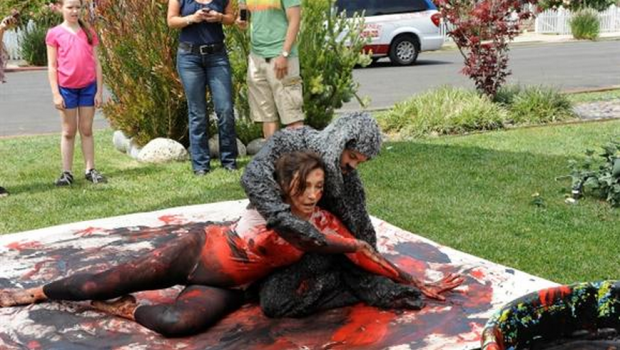Artists on TV shows fall prey to plenty of stereotypes. (Artists be crazy, anyone?) Today we’re just going to scratch the surface of the rainbow variety of as-seen-on-TV artist craziness with shows like Wilfred, Doctor Who, and Six Feet Under.
Wilfred: Season 1, episode 9
Where to watch: Netflix, Amazon, iTunes
Wilfred is a show about Ryan (Elijah Wood), a very depressed lawyer who believes he can talk to his neighbor’s dog Wilfred. They also smoke a lot of pot in Ryan’s basement. He’s barely functional, but still not as looney as his mother who has been a resident at a very posh mental institution since he was a kid. She wears crazy hats, makes fishstick-and-peanut-butter sandwiches for breakfast, and surprise—she’s an artist. Here, to demonstrate the ascending staircase of artist-craziness:
- After painting at an easel, she doesn’t realize that she has red paint on her hands and wipes it all over Ryan’s face. She calls him an “Indian chief” then adds, “That was a little racist but it was a little fun.”
- Because that face-painting is only a free-spirited move, Ryan’s mom gets to leave the asylum.
- Once she’s out, she starts rolling around in kiddie pools full of paint on Ryan’s front lawn. She tells Ryan she’s only doing it because she didn’t want to make the house a mess, then rejoins, “What does it look like, silly? I’m making a statement about corporate greed and interpretive selflessness through movement-painting.”
How stereotypically stereotypical is it?
Legitimately mentally ill people make crazy art. Painting at an easel will make you seem less looney than rolling around in paint.
Six Feet Under: Season 5, episode 4
Where to watch: HBO Go
This was actually a pretty fantastic show but that doesn’t mean it was immune to the “artist as tortured lunatic” trope. The series was about a family who owns a funeral home, so there was a bit of a “tortured lunatic” theme inherent in it from the get go. The show’s artists take this to the next level, though. Claire, the youngest sibling in the family, attends art school, shit gets crazy, and she drops out. In this episode, after she’s taken to a more corporate lifestyle, she revisits her drug riddled, self-destructive art buddies at their group show. Everybody is unhinged:
- She runs into an ex-boyfriend, Russell, who says coyly after sipping out of a bottle of wine, “My work has gone to amazing places ever since I was hit by a car.” When Claire asks how it happened, he responds, “To be honest, I prefer to process those emotions through my art.” Ugh.
- Russell laments that a giant sculpture of a lollipop looks like a dick. Because he hates (but also is in love with) the guy who made it, he look as if he is about to cry.
- Russell smashes said dick lollipop with his wine bottle as he shrieks “It’s indestructible! Fucking indestructible!” He tries to lift it out of the ground, then gets wrestled to the ground.
- Claire’s art teacher/lover is bipolar and has gone off his meds. Previously he had followed her brother and takes a picture of him peeing on a wall. Later, he leads her brother into a warehouse decorated in doll heads and holds a boxcutter to his throat while opera music is playing.
How stereotypically stereotypical is it?
Artists are unhinged lunatics who might either paint you or smash you over the head with a wine bottle. At least this scene, unlike most, does not end in a giant artist orgy.
Doctor Who: Series 2, episode 12
Here’s just a tad bit of space-y wisdom from TV’s best-known timetraveller, Doctor Who: “If living things can become drawings, then maybe drawings can become living things.”
Well, then, that explains why a pre-teen girl who likes to draw gets possessed by a lost Isolus who uses her to scribble a demon into being. Also, if she draws someone, that person or thing—a cat, even—gets sucked up into the Isolus’s make-believe world so that it can have a friend. So what seems at first to be a case of assuming this girl is a crazy artist, she’s not—it’s the alien who’s possessed her and who now uses drawing for evil.
How stereotypically stereotypical is it?
Less than average: It starts out with the crazy artist stereotype, then flips that on its head by pulling out the crazy-alien artist stereotype. Maybe in the Whoverse that’s almost the same thing.



{ 1 comment }
This is great. It’s worth mentioning that Jim Gaylord has been doing this brilliantly in his Art in the Movies blog: http://artinthemovies.wordpress.com/.
Comments on this entry are closed.